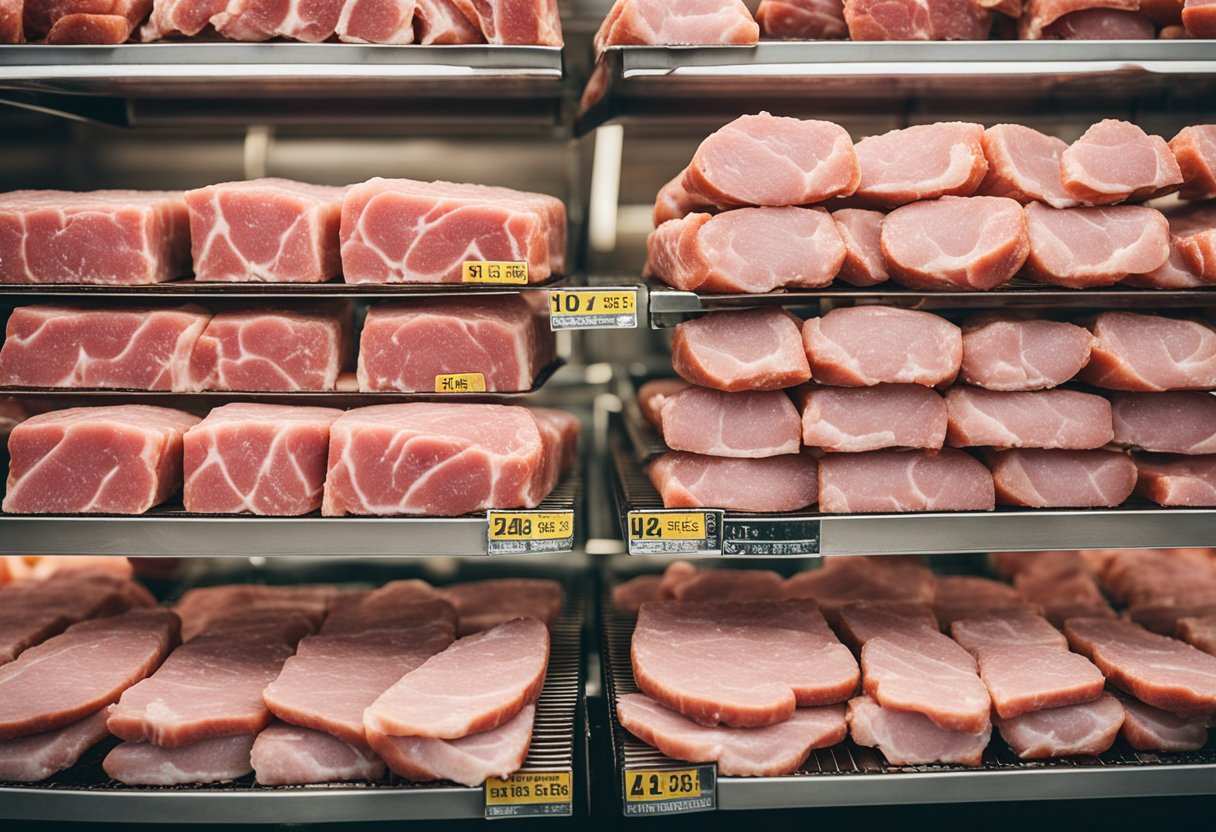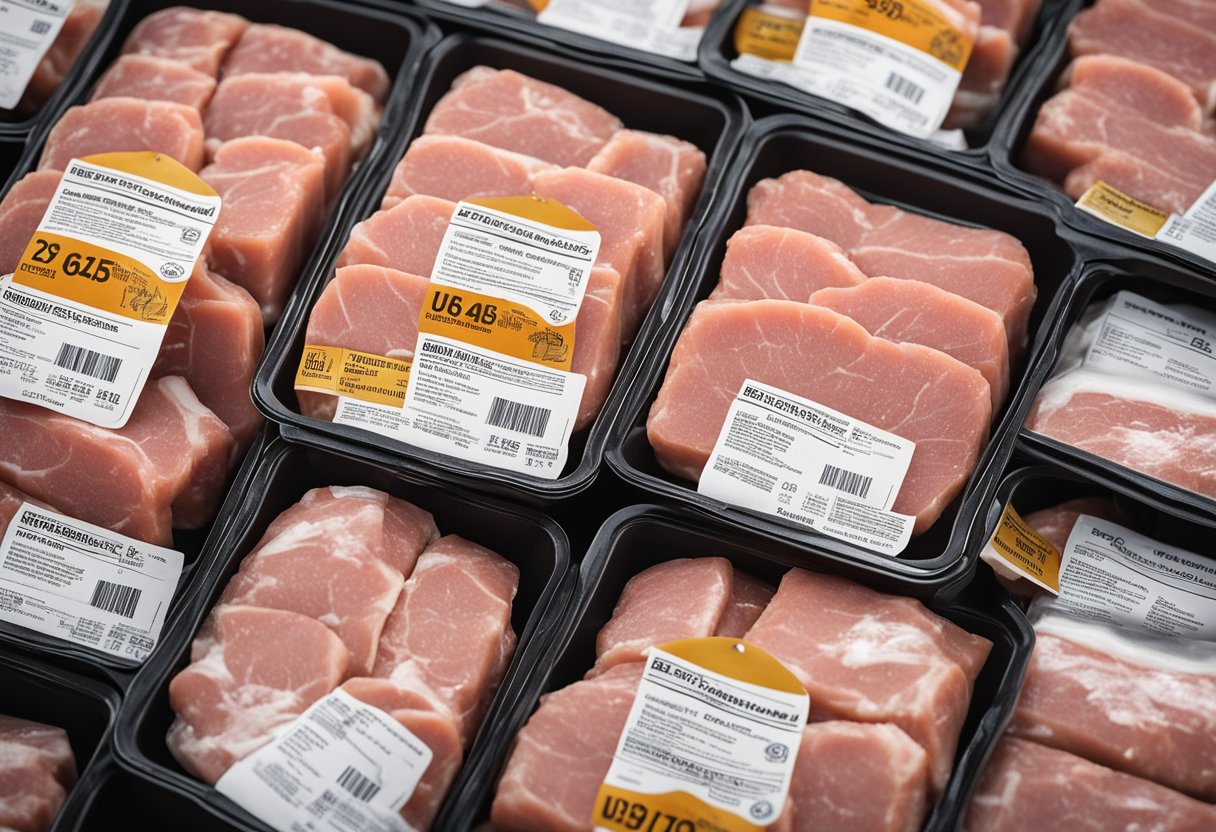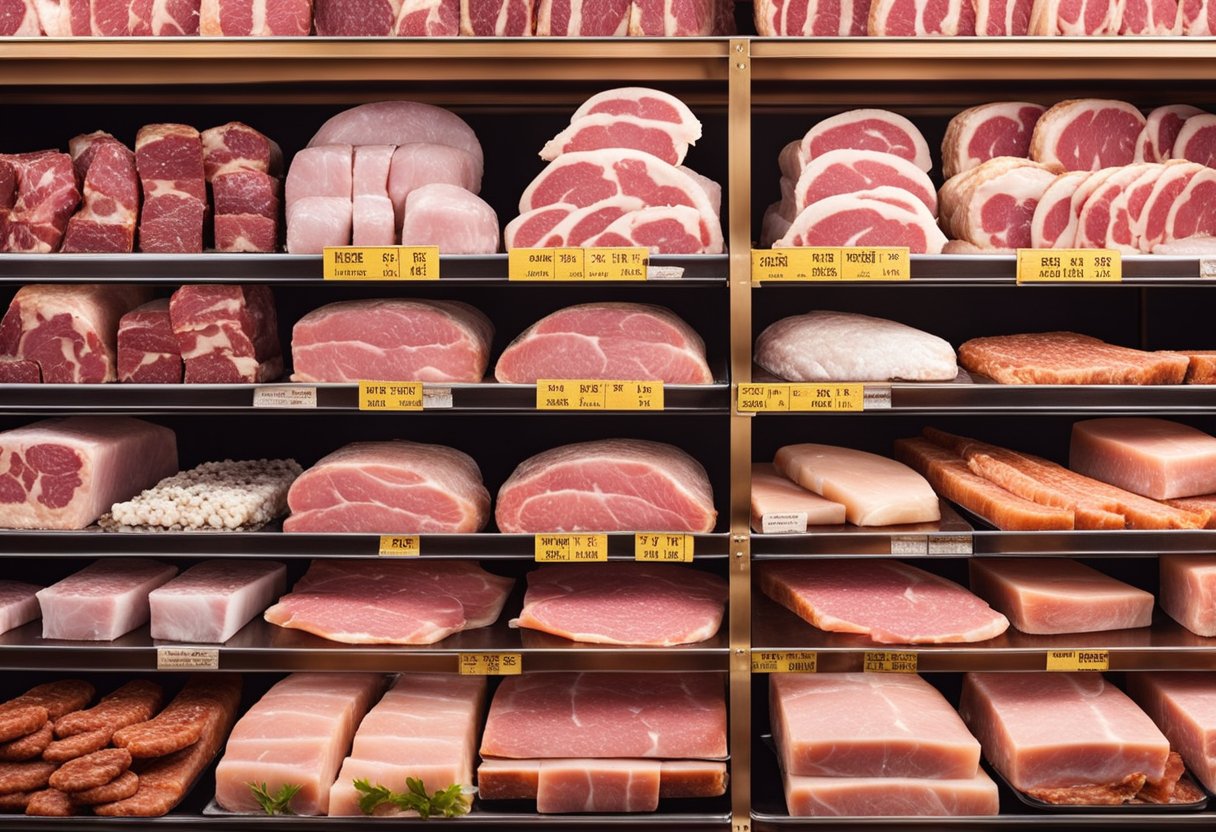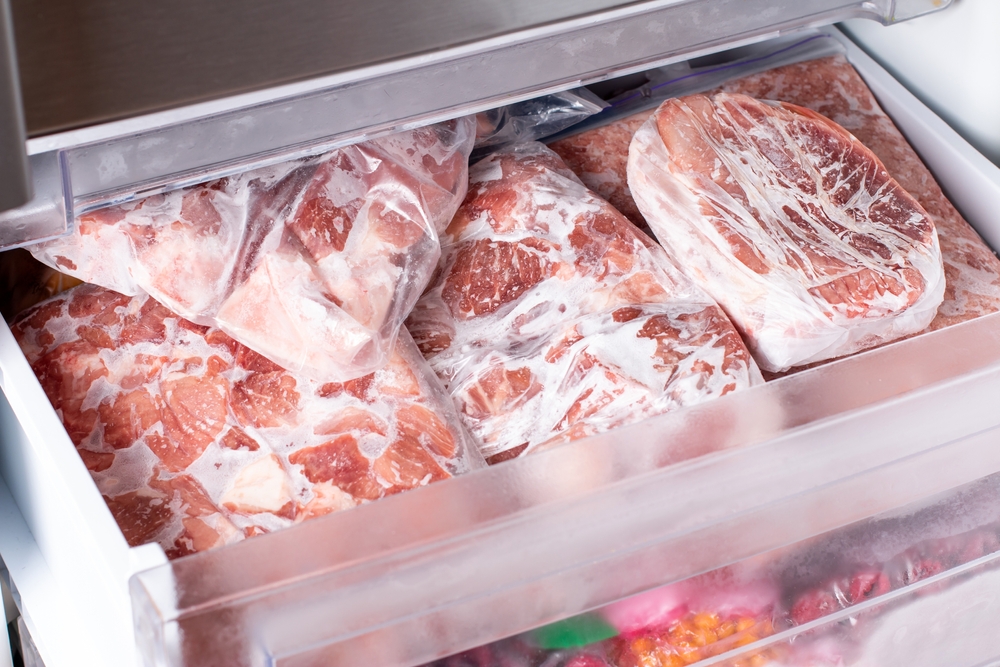I researched the topic of whether it is safe to eat 2-year-old frozen meat and found that it is safe to eat meat that was frozen for 2 years. According to the U.S. Department of Agriculture, food stored constantly at 0 °F will always be safe.
Only the quality suffers with lengthy freezer storage. While technically safe to eat, the quality of the meat may suffer over time, including changes to its color, flavor, and texture.

The U.S. Food and Drug Administration has developed specific timelines for freezing different types of meat, and while it may be safe to eat frozen meat that has been stored correctly using the USDA’s recommended practices, it’s not advised due to the quality issues that can take place.
The impact of packaging on frozen meat, as well as the type of meat and its freezing lifespan, can also affect the safety and quality of the meat.
Key Takeaways
- Frozen meat stored at 0 °F will always be safe to eat, but its quality may suffer over time.
- The USDA and FDA have guidelines for storing and freezing meat, and it’s important to follow them to ensure safety and quality.
- Proper storage and thawing methods, as well as being aware of signs of spoilage, can help prevent health risks associated with consuming old frozen meat.
Understanding Frozen Meat
As someone who has worked in the food industry for years, I have come across many questions about the safety of eating frozen meat.
The truth is, freezing meat is a great way to preserve it for a long time, but it can also affect its quality and texture.
When meat is frozen, the water inside it turns into ice crystals. These ice crystals can cause damage to the meat’s cell structure, which can affect its texture, color, and flavor.
However, if the meat is frozen properly and kept at a constant temperature of 0°F or below, it can be safe to eat even after two years.
It’s important to note that while frozen meat may be safe to eat, the quality may suffer after a certain amount of time.
Freezing can cause the meat to lose moisture, which can result in a dry and tough texture. Additionally, the longer the meat is frozen, the more likely it is to develop freezer burn, which can affect the taste and texture.
To ensure the best quality of frozen meat, it’s important to follow proper freezing and thawing techniques. When freezing meat, it’s best to wrap it tightly in plastic wrap or aluminum foil and place it in an airtight container or freezer bag.
Label the container with the date it was frozen, so you can keep track of how long it has been in the freezer.
When thawing frozen meat, it’s important to do so safely to avoid the growth of harmful bacteria. The safest way to thaw meat is to place it in the refrigerator and allow it to thaw slowly over a period of several hours or overnight.
Avoid thawing meat at room temperature, as this can cause the outer layer to thaw more quickly than the inside, which can create an environment for bacteria to grow.
In conclusion, while frozen meat can be safe to eat after two years, it’s important to consider the quality and texture of the meat. Proper freezing and thawing techniques can help preserve the quality of the meat and ensure its safety for consumption.
Safety of Consuming 2 Year Old Frozen Meat
As someone who enjoys cooking and eating meat, I have often wondered if it is safe to consume 2 year old frozen meat.
According to the U.S. Department of Agriculture (USDA), it is safe to eat meat that was frozen for 2 years or even longer. This is because the freezing process prevents the growth of bacteria that can cause food poisoning.
However, it is important to note that the quality of the meat may suffer after prolonged freezing. Freezing can cause changes in the texture and flavor of the meat, and it may become dry or tough.
To ensure the best quality, it is recommended to consume frozen meat within 6 to 12 months of freezing.
To maintain the safety and quality of frozen meat, it is important to store it at a constant temperature of 0°F or below. Any fluctuations in temperature can cause the meat to spoil and increase the risk of food poisoning.
It is also important to properly thaw frozen meat before cooking. Thawing meat at room temperature can cause bacteria to grow and increase the risk of food poisoning.
The safest way to thaw frozen meat is to place it in the refrigerator for several hours or overnight.
In conclusion, it is safe to eat 2 year old frozen meat as long as it has been stored at a constant temperature of 0°F or below and properly thawed before cooking.
However, the quality of the meat may suffer after prolonged freezing, so it is recommended to consume frozen meat within 6 to 12 months of freezing.
USDA and FDA Guidelines

As per the guidelines provided by the U.S. Department of Agriculture (USDA) and the Food and Drug Administration (FDA), frozen meat can be safe to eat even after two years of storage in the freezer. However, the quality of the meat may be compromised.
The USDA recommends that frozen steak can be stored in the freezer for a period of six to twelve months.
As for fresh chicken and other types of poultry, the FDA suggests freezing it for nine months to one year, depending on whether you’re freezing a whole bird or individual segments.
It is important to note that the guidelines provided by the USDA and FDA are just recommendations, and the quality of the meat can vary depending on how it was stored and the temperature of the freezer.
The longer the meat is stored in the freezer, the more likely it is to lose its texture and flavor.
To ensure the safety of frozen meat, it is important to store it at a temperature of 0°F (-18°C) or below. This will prevent bacteria from growing and reduce the risk of foodborne illness.
In summary, while it may be safe to eat frozen meat that has been stored for two years, it is important to consider the quality of the meat before consuming it. Always follow the guidelines provided by the USDA and FDA for safe food storage and handling.
Impact of Packaging on Frozen Meat
When it comes to freezing meat, proper packaging is crucial to ensure its safety and quality. The packaging material and method used can significantly impact the meat’s ability to retain its flavor, texture, and nutritional value.
Plastic wrap, aluminum foil, and freezer paper are common packaging materials used for freezing meat. However, these materials are not airtight and can lead to freezer burn, which affects the meat’s taste and texture.
To prevent freezer burn, it is best to use airtight containers or freezer bags. These containers and bags are specifically designed for freezing and can help prevent air from reaching the meat, preserving its quality and flavor.
It is also important to consider the original packaging of the meat. If the meat was purchased in a vacuum-sealed bag or an airtight container, it is best to leave it in the original packaging and place it directly in the freezer.
This will help prevent any contamination and maintain the meat’s quality.
When using an airtight container or freezer bag, it is essential to remove as much air as possible before sealing it.
This can be done by using a vacuum-sealing machine or manually pressing out the air. Removing the air will help prevent freezer burn and prolong the meat’s shelf life.
In conclusion, the packaging material and method used for freezing meat can significantly impact its safety and quality. It is essential to use airtight containers or freezer bags and remove as much air as possible to prevent freezer burn and maintain the meat’s quality.
Types of Meat and Their Freezing Lifespan

When it comes to freezing meat, different types of meat have different freezing lifespans.
Here are some of the most common types of meat and their recommended freezing lifespan:
- Chicken and Poultry: Whole chickens and turkeys can last up to a year in the freezer, while cut poultry pieces can last up to nine months. It’s important to note that the FDA recommends freezing poultry for no more than one year to maintain quality and safety.
- Beef: Fresh cuts of beef can last for between 4 and 12 months in the freezer. Raw steaks and roasts can last up to a year, while ground beef has a freezer shelf life of only three to four months.
- Pork: Fresh cuts of pork can last for between 6 and 8 months in the freezer. Bacon, sausage, and hot dogs can last for up to 2 months.
- Veal: Fresh cuts of veal can last for between 8 and 12 months in the freezer.
- Lamb: Fresh cuts of lamb can last for between 6 and 9 months in the freezer.
- Ham: Whole ham can last up to 6 months in the freezer, while sliced ham can last up to 2 months.
- Fish and Seafood: Most types of fish and seafood can last up to 6 months in the freezer. However, fatty fish such as salmon and tuna can last up to 8 months.
It’s important to note that while frozen meat is safe to eat, it can still lose quality over time. Freezing can cause changes in texture and flavor, so it’s always best to use frozen meat within the recommended freezing lifespan for the best quality.
Signs of Spoilage in Frozen Meat
As a chef, I know that frozen meat can be a lifesaver when you need to whip up a quick meal. However, it’s important to know when your frozen meat has gone bad. Here are some signs of spoilage to look out for:
Changes in Color
If your frozen meat has gone bad, it may have changes in color. For example, beef may turn brown or gray, while chicken may turn gray or greenish. These changes in color are due to the growth of bacteria or mold, which can cause the meat to spoil.
Smell
One of the most obvious signs of spoilage in frozen meat is a bad smell. If your meat has a sour or ammonia-like odor, it’s likely gone bad. Trust your sense of smell and discard any meat that smells off.
Slimy Texture
Another sign of spoilage in frozen meat is a slimy texture. If your meat feels slimy or sticky to the touch, it’s likely gone bad. This slimy texture is due to the growth of bacteria, which can cause the meat to spoil.
Freezer Burn
Freezer burn is another sign of spoilage in frozen meat. If your meat has white or grayish-brown spots on it, it’s likely suffered from freezer burn.
Freezer burn is caused by the dehydration of the meat due to exposure to air. While it’s not harmful to eat, it can affect the taste and texture of the meat.
In conclusion, it’s important to know the signs of spoilage in frozen meat to ensure that you’re eating safe and healthy food. If you notice any of these signs in your frozen meat, it’s best to discard it and purchase fresh meat.
Proper Storage and Thawing Methods
As I mentioned earlier, frozen meat can be safe to eat even after two years. However, proper storage and thawing methods are crucial in maintaining the quality and safety of the meat.
Firstly, it is important to store frozen meat at a constant temperature of 0°F or below to prevent temperature fluctuations that can cause freezer burn.
Freezer burn occurs when moisture evaporates from the surface of the meat, causing it to become dry and discolored. While freezer burn does not pose a health risk, it can affect the taste and texture of the meat.
When it comes to thawing frozen meat, there are three safe methods: refrigerator thawing, cold water thawing, and microwave thawing.
Refrigerator thawing is the safest method as it allows the meat to thaw at a consistent temperature of around 40°F. Simply place the frozen meat in the refrigerator and allow it to thaw for several hours to a few days, depending on the size of the meat.
Cold water thawing is a quicker method, but requires more attention. Place the frozen meat in a leak-proof plastic bag and submerge it in cold water.
Change the water every 30 minutes to ensure that it stays cold. This method can take several hours to thaw the meat completely.
Microwave thawing is the fastest method, but it can also be the riskiest. Make sure to follow the microwave’s instructions for defrosting meat and use the defrost setting.
It is important to cook the meat immediately after thawing it in the microwave to prevent bacterial growth.
It is important to note that once meat is thawed, it should be cooked immediately to prevent bacterial growth. Do not refreeze thawed meat as this can also cause bacterial growth and affect the quality of the meat.
By following these proper storage and thawing methods, you can ensure that your frozen meat is safe to eat and maintains its quality.
Health Risks Associated with Old Frozen Meat
As a food safety expert, I have researched and analyzed the potential health risks associated with consuming 2-year-old frozen meat.
While it is generally safe to consume frozen meat that has been stored at zero or sub-zero temperatures, there are certain risks that you should be aware of.
One of the primary risks associated with old frozen meat is the growth of harmful bacteria. Even when frozen, meat can still be a breeding ground for microorganisms that can cause foodborne illnesses.
This is especially true if the meat was not stored at the correct temperature, as warmer temperatures can encourage microbial growth.
Another risk to consider is the quality of the meat. Over time, frozen meat can become freezer burned, which can affect its taste and texture. While this may not necessarily pose a health risk, it can make the meat less enjoyable to eat.
To minimize the risks associated with old frozen meat, it is important to follow proper storage procedures. This includes making sure the meat is frozen at the correct temperature and stored in airtight packaging to prevent freezer burn.
Additionally, it is important to thaw the meat properly before cooking, as improper thawing can also lead to the growth of harmful bacteria.
In conclusion, while it is generally safe to consume 2-year-old frozen meat that has been stored properly, there are still certain risks to be aware of.
By following proper storage and thawing procedures, you can minimize these risks and enjoy your frozen meat safely.
Conclusion

In conclusion, it is safe to eat 2-year-old frozen meat if it was stored properly. However, the quality of the meat may have deteriorated over time, which can affect its texture, flavor, and color.
It’s important to note that the U.S. Food and Drug Administration (FDA) has developed specific timelines for freezing different types of meat, and it’s recommended to follow those guidelines to ensure the best quality and safety.
If you have frozen meat that has been stored for more than 2 years, it’s best to inspect it carefully before consuming it. Look for signs of spoilage such as freezer burn, discoloration, and an off smell.
If the meat looks or smells questionable, it’s better to err on the side of caution and discard it.
To ensure the safety and quality of your frozen meat, it’s important to store it in a freezer that maintains a temperature of 0°F or below.
Label the meat with the date of freezing and try to use it within the recommended timeframe for best quality.
In summary, while it is safe to eat 2-year-old frozen meat if it was stored properly, it’s important to inspect it carefully before consuming it and to follow FDA guidelines for freezing times.
By taking these precautions, you can enjoy your frozen meat with peace of mind.
Frequently Asked Questions
How long can meat be safely stored in the freezer?
Meat can be safely stored in the freezer for several months to a year, depending on the type of meat and how it is stored. According to the USDA, frozen meat can be stored indefinitely, but the quality may deteriorate over time.
Is it safe to consume meat that has been frozen for two years?
The safety of consuming meat that has been frozen for two years depends on how the meat was stored. If the meat was stored properly at a consistent temperature of 0°F (-18°C) or below, and there are no signs of spoilage, then it is generally safe to eat.
However, if the meat was not stored properly, or there are signs of spoilage such as a foul odor or slimy texture, then it should be discarded.
What are the risks of eating expired frozen meat?
Eating expired frozen meat can pose several risks, including food poisoning and bacterial infections. As meat ages, bacteria can grow and multiply, increasing the risk of foodborne illness.
Additionally, expired meat may have a foul odor or slimy texture, indicating that it has spoiled and should not be consumed.
How can you tell if frozen meat has gone bad?
There are several signs that frozen meat has gone bad, including a foul odor, slimy texture, or discoloration.
Additionally, if the meat has been stored in the freezer for an extended period of time, it may develop freezer burn, which can cause a dry, leathery texture and a loss of flavor.
What is the recommended maximum storage time for frozen meat?
The recommended maximum storage time for frozen meat varies depending on the type of meat. Generally, beef, pork, and lamb can be stored in the freezer for 6-12 months, while chicken and turkey can be stored for 6-8 months. Fish and shellfish can be stored for up to 6 months.
Can freezer burn make frozen meat unsafe to eat?
Freezer burn does not make frozen meat unsafe to eat, but it can affect the quality of the meat. Freezer burn occurs when the surface of the meat becomes dehydrated, causing it to become dry and leathery.
While the meat may still be safe to eat, it may have a less desirable texture and flavor.







